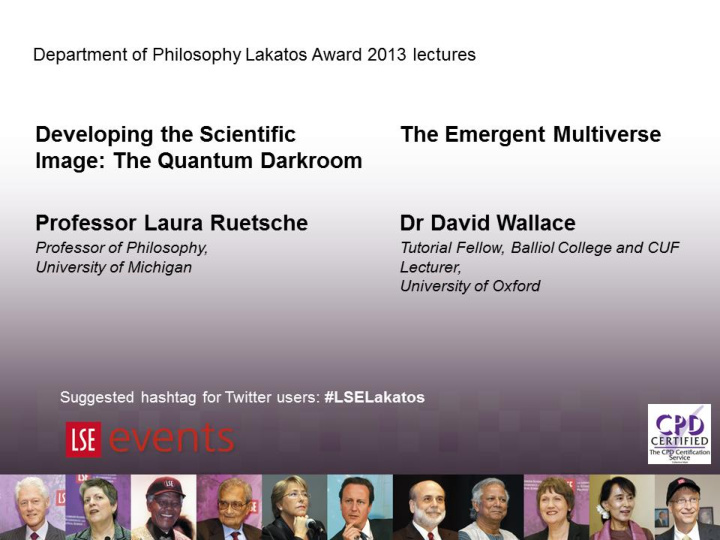



Quantum Theory and the Many- Worlds Interpretation David Wallace (Balliol College, Oxford) LSE, October 2014
Interpreting superpositions |live cat> - represents system with a living cat in
Interpreting superpositions |live cat> - represents system with a living cat in |dead cat> - represents same system where the cat is dead
Interpreting superpositions |live cat> - represents system with a living cat in |dead cat> - represents same system where the cat is dead a|live cat> + b|dead cat> - represents ??????????????
Probabilities and amplitudes Born rule: When superpositions are measured , the mod-squared amplitude of a term in the superposition is the probability that the measurement outcome corresponds to that term
Probabilities and amplitudes Born rule: When superpositions are measured , the mod-squared amplitude of a term in the superposition is the probability that the measurement outcome corresponds to that term Probability interpretation: Superpositions represent systems in an unknown but definite state
Problems for probabilistic interpretation
Problems for probabilistic interpretation Interference
Problems for probabilistic interpretation Interference Kochen-Specker Theorem Gleason’s Theorem Pusey-Barrett-Rudolph theorem
The Measurement Problem
The Measurement Problem Microscopic quantum states cannot be interpreted probabilistically because of interference
The Measurement Problem Microscopic quantum states cannot be interpreted probabilistically because of interference Macroscopic quantum states cannot be interpreted physically because of Schrodinger cat states
The Measurement Problem Microscopic quantum states cannot be interpreted probabilistically because of interference Macroscopic quantum states cannot be interpreted physically because of Schrodinger cat states Actual physical practice shifts inchoately between these interpretations
Change the philosophy?
Change the philosophy? Operationalism?
Change the philosophy? Operationalism? Complementarity?
Change the philosophy? Operationalism? Complementarity? Quantum logic?
Change the physics?
Change the physics? Collapse of the wavefunction
Change the physics? Collapse of the wavefunction? Hidden variables?
Change the physics? Collapse of the wavefunction? Hidden variables? Retrocausation?
The paradox of electromagnetism
The paradox of electromagnetism A(x,y,z,t)- represents a pulse of radio waves going from Earth to Moon
The paradox of electromagnetism A(x,y,z,t)- represents a pulse of radio waves going from Earth to Moon B(x,y,z,t)- represents a pulse of radio waves going from Mars to Venus
The paradox of electromagnetism A(x,y,z,t)- represents a pulse of radio waves going from Earth to Moon B(x,y,z,t)- represents a pulse of radio waves going from Mars to Venus a A(x,y,z,t) + b B(x,y,z,t) – represents ??????????
The Emergent Multiverse?
The Emergent Multiverse? Physics (decoherence) tells us that the quantum state, at large scales, has the structure of a branching multiverse with the branches obeying quasiclassical dynamics
The Emergent Multiverse? Physics (decoherence) tells us that the quantum state, at large scales, has the structure of a branching multiverse with the branches obeying quasiclassical dynamics Philosophy tells us (should tell us!) that higher-order ontology is a matter of autonomous higher-order structure and dynamics
Two Problems of Probability
Two Problems of Probability (1) What, if anything, is the categorical basis for probabilities?
Two Problems of Probability (1) What, if anything, is the categorical basis for probabilities? (2) Why does that categorical basis play the probability role? Lewis: Principal Principle? Papineau: Inferential & Decision-Theoretic Links
The “what” problem
The “what” problem Frequentism?
The “what” problem Frequentism? Best-systems analysis?
The “what” problem Frequentism? Best-systems analysis? Bare postulate?
The “what” problem Frequentism? Best-systems analysis? Bare postulate? Everett: probabilities are mod-squared amplitudes in regimes where decoherence guarantees they obey the probability calculus
The “Why” problem “[I]s there any way that any Humean magnitude could fill the chance-role? Is there any way that an unHumean magnitude could? What I fear is that the answer is “no” both times! Yet how can I reject the very idea of chance, when I know full well that each tritium atom has a certain chance of decaying at any moment?” (Lewis)
The “Why” problem, Everett -style
The “Why” problem, Everett -style Probability from locality (Zurek, Carroll/Sebens)
The “Why” problem, Everett -style Probability from locality (Zurek, Carroll/Sebens) Probability from decision theory (Deutsch, Greaves, Myrvold, DW)
The “Why” problem, Everett -style Probability from locality (Zurek, Carroll/Sebens) Probability from decision theory (Deutsch, Greaves, Myrvold, DW) The Everettian Epistemic Theorem (EM 218-223) (roughly) “An agent who obeys normal decision -theoretic axioms, and who considers Everettian QM as a live epistemic probability, will treat mod- squared amplitudes in that theory as probabilities”
Recommend
More recommend